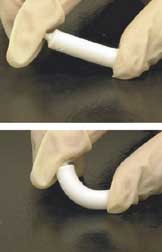
Photo from wikipedia
Background: Autologous bone grafts remain a standard of care for the reconstruction of large bony defects, but limitations persist. The authors explored the bone regenerative capacity of customized, three-dimensionally printed… Click to show full abstract
Background: Autologous bone grafts remain a standard of care for the reconstruction of large bony defects, but limitations persist. The authors explored the bone regenerative capacity of customized, three-dimensionally printed bioactive ceramic scaffolds with dipyridamole, an adenosine A2A receptor indirect agonist known to enhance bone formation. Methods: Critical-size bony defects (10-mm height, 10-mm length, full-thickness) were created at the mandibular rami of rabbits (n = 15). Defects were replaced by a custom-to-defect, three-dimensionally printed bioactive ceramic scaffold composed of &bgr;-tricalcium phosphate. Scaffolds were uncoated (control), collagen-coated, or immersed in 100 &mgr;M dipyridamole. At 8 weeks, animals were euthanized and the rami retrieved. Bone growth was assessed exclusively within scaffold pores, and evaluated by micro–computed tomography/advanced reconstruction software. Micro–computed tomographic quantification was calculated. Nondecalcified histology was performed. A general linear mixed model was performed to compare group means and 95 percent confidence intervals. Results: Qualitative analysis did not show an inflammatory response. The control and collagen groups (12.3 ± 8.3 percent and 6.9 ± 8.3 percent bone occupancy of free space, respectively) had less bone growth, whereas the most bone growth was in the dipyridamole group (26.9 ± 10.7 percent); the difference was statistically significant (dipyridamole versus control, p < 0.03; dipyridamole versus collagen, p < 0.01 ). There was significantly more residual scaffold material for the collagen group relative to the dipyridamole group (p < 0.015), whereas the control group presented intermediate values (nonsignificant relative to both collagen and dipyridamole). Highly cellular and vascularized intramembranous-like bone healing was observed in all groups. Conclusion: Dipyridamole significantly increased the three-dimensionally printed bioactive ceramic scaffold’s ability to regenerate bone in a thin bone defect environment.
Journal Title: Plastic and Reconstructive Surgery
Year Published: 2019
Link to full text (if available)
Share on Social Media: Sign Up to like & get
recommendations!